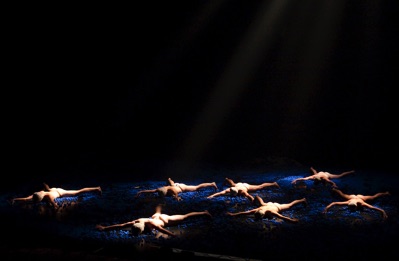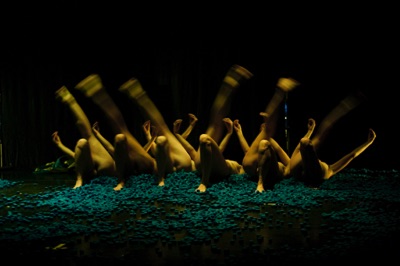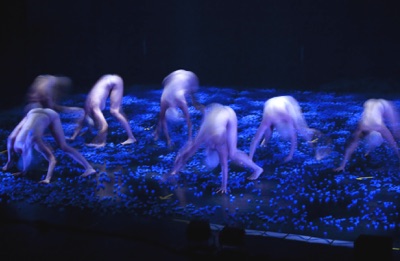
This production comes full circle aesthetically as well, a circle which goes back a long ways: in 1985 the collective Vorgänge demonstrated a first outline of the body performance «Lufus» in the priestess Aloufoo’s sacred grove in the Southern Senegalese village of Fangoumé. The year after, «Lufus» won second prize in the Bagnolet/Paris competition’s choreography category and a prize for the most innovative choreography. The editta braun company, formed in 1989, originated from this collective, and, ten years later, elaborated on the performance’s basic ideas with the full-length piece «Luvos, vol. 2», which premiered in 2001. Since then, this choreography has been presented to ca. 12,000 people in 15 countries and 27 different cities. For the first time, «planet LUVOS» confronts the surreal Luvos body worlds with the human form of a freely-moving dancer – dream and reality, vision and real time meet in an unmistakeable dramatic dance moment.
For over ten years, reflecting about human self-destruction has repeatedly and consciously determined the direction of our dance-research. The analysis of Manfred Wöhlckes’ thesis of „social entropy“ («manifest», 2002), the fantasy about the frightening prospects of gen manipulation («oXalis», 2005), the parable about a guilt-filled society ossifying in silence («Coppercity», 2007), the diagnosis of the increasing loss of a sense of the present through exaggerated expectations of being saved in the future («Wenn ich einmal tot bin, komme ich ins Paradies», 2008), the confrontation with the ineradicability of war and the collapse of all utopias («King Arthur», 2010), and finally with the question of whether art is justified in view of present day humanitarian and ecological catastrophes («schluss mit kunst», 2011) – all this leads, if not to despair and resignation, to an increasingly urgent search for a solution, or – if it’s really too late for that – at least for the reason why it’s too late.
With «planet LUVOS» the circle of these questions is complete. It points - in a consoling way – to the part of and in us which we humans have neglected for too long, or even completely forgotten. In that the downfall of mankind is described as a return to an all-organic existence, in that individual destruction is not experienced as a loss, but rather as a harmonic merging into a larger whole. We accompany the last person on Earth – a young woman – as she confronts the, at first frightening and eerie, strangely disconcerting submarine creatures, who in the end welcome her into their still and harmonious world. What remains is at any rate larger that mankind.
«planet LUVOS»
premiere: 27 September 2012, Brucknerfest Linz
dance & movement research: Dorota Karolina Łęcka (PL), Andrea Maria Handler, Katja Bablick (DE), Sandra Hofstötter, Martyna Lorenc (PL)
dramaturgy: Gerda Poschmann-Reichenau (DE)
composition: Thierry Zaboitzeff (FR)
lightdesign: Peter Thalhamer
choreographic assistance: Barbara Motschiunik, Dante Murillo (CO)
idea, choreograpy, artistic direction: Editta Braun
«planet LUVOS»
(2012)



Reactions on «planet LUVOS»
What remains is greater than man
“planet LUVOS”, the editta braun company’s fascinating dance premiere at the Bruckner Festival
The Salzburg choreographer Editta Braun leads us through a blue underwater world back to the origins of life. In her new piece “planet LUVOS”, she completes the round dance of surreal body worlds, which began with “Lufus” (1985) and continued with “Lufus, vol. 2”, about the dangers of genetic engineering. The viewer sinks into a blue, bubbling waterworld. The only sign that humans exist is the distant sound of a steamship whistle, somewhere far away. And a woman who suddenly finds herself in a kingdom full of strange, but peaceful beings. Seven dancers (Katja Bablick, Andrea Maria Handler, Sandra Hofstötter, Dorota Karolina Lecka, Martyna Lorenc, Marcella Mancini and Spela Vodeb) constitute this symbiotic, sensitive collective. Their legs wave in the air like anemone arms, each movement reacting as fast as lightning to the other . Their bodies lose their humanness and become entities. Naked torsi move like alien beings across the stage. These are fascinating images, a thoroughly successful illusion, underscored by Peter Thalhamer’s perfect light design and Thierry Zaboitzeff’s spare underwater sound.
The arms enfold the human being in a nearly tender way, and it willingly surrenders to the gentle embrace. What appears to be the end is a consoling dissolution of the individual into the greater whole. Long, enthusiastic applause.“ Upper Austrian News, September 29, 2012
Photos: Bettina Frenzel